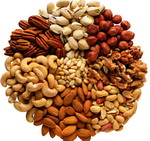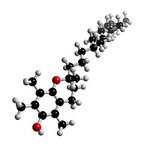|
Vitamin E – The Tocopherols And TocotrienolsVitamin E is not one compound but two sets of four compounds each, the tocopherols composed of an alpha, beta, gamma and delta compound and the tocotrienols also composed of an alpha, beta, gamma and delta compound. The alpha tocopherol is the most common form of the vitamin found in food.
Vitamin E Molecule
The vitamin is absorbed through the GI tract where 20-80% is absorbed, and like other fat soluble vitamins through dietary fat, and is dispensed throughout the body via lipoproteins. As the amount of the vitamin increases the amount in the GI tract decreases. The vitamin is not stored in the liver like other fat soluble vitamins, adipose (fat) tissue stores 90% of the vitamin, with the remaining found in just about every cell in the body. The excess vitamin is excreted with the fecal matter. Function of The Vitamin Vitamin E is considered an antioxidant. What is an antioxidant? This is a substance that combines with or neutralizes a free radical, which prevents oxidative damage to cells and tissues. What is a free radical? A free radical is a highly unstable toxic molecule that is created during the metabolic process by the action of oxygen which causes otherwise stable molecules to lose an electron and to be incomplete, which causes the incomplete nonstable molecule to attack cell membranes, cell constituents, including DNA, this is important because it can make it possible for the beginning of chronic diseases such as atherosclerosis and cancer.
It is antioxidants that eliminate these free radicals by stabilizing or neutralizing these molecules. Other antioxidant functions of the vitamin include protection of the lungs from environmental damage, may help protect against the onset of cancers by protecting the body against DNA mutations, helps to prevent cardiovascular disease, and helps to protect the eye, liver, breast and muscle tissues. Dietary Recommendations Vitamin E has its place in cell membranes and other fat rich tissues and serves as one of the best defenses against free radical damage. Polyunsaturated fat in cell membranes are especially vulnerable to free radicals. By taking in 15 milligrams which is equal to 22 IU (international units) per day of the vitamin, where 1 IU = .67 milligrams of alpha tocopherol from natural food sources and 1 IU = .45 milligrams from the synthetic vitamin, the risk of chronic disease is decreased. The required intake of the vitamin must be based on body size and polyunsaturated fat intake. Sources of The Vitamin The active alpha tocopherol form of vitamin is found in a variety of plant and animal foods with animal foods being the poorer source of the two. The highest amount of the vitamin can be found in wheat germ oil, other oils such as cottonseed, safflower, and sunflower oils are rich sources as are margarine and salad dressings, seeds and nuts, along with strawberries and some green leafy vegetables, but most fruits and vegetables in general contain only small amounts of the active form of the vitamin. The cooking, processing and storage of foods substantially reduces the content of the vitamin. 

Vitamin Deficiency and Toxicity Deficiency of the vitamin is rare in North America except in those individuals with such diseases as cystic fibrosis which is an abnormality of fat absorption.
The vitamin is relatively nontoxic since it is virtually impossible to consume too much of the vitamin, although large doses can interfere with normal blood clotting.
For other information on nutrition some great references are: • Nutrition – Fourth Edition by Paul Insel, Don Ross, Kimberley McMahon, and Melissa Bernstein
Vitamins
|






